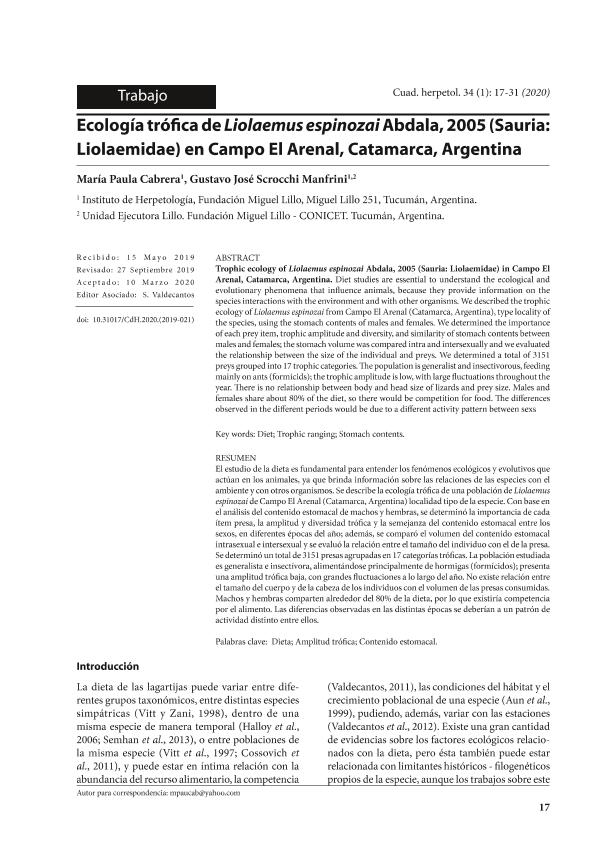Artículo
Trophic ecology of Liolaemus espinozai Abdala, 2005 (Sauria: Liolaemidae) in Campo El Arenal, Catamarca, Argentina. Diet studies are essential to understand the ecological and evolutionary phenomena that influence animals, because they provide information on the species interactions with the environment and with other organisms. We described the trophic ecology of Liolaemus espinozai from Campo El Arenal (Catamarca, Argentina), type locality of the species, using the stomach contents of males and females. We determined the importanceof each prey item, trophic amplitude and diversity, and similarity of stomach contents between males and females; the stomach volume was compared intra and intersexually and we evaluated the relationship between the size of the individual and preys. We determined a total of 3151 preys grouped into 17 trophic categories. The population is generalist and insectivorous, feeding mainly on ants (formicids); the trophic amplitude is low, with large fluctuations throughout theyear. There is no relationship between body and head size of lizards and prey size. Males and females share about 80% of the diet, so there would be competition for food. The differences observed in the different periods would be due to a different activity pattern between sexs Diet studies are essential to understand the ecological and evolutionary phenomena that influence animals, because they provide information on the species interactions with the environment and with other organisms. We described the trophic ecology of Liolaemus espinozai from Campo El Arenal (Catamarca, Argentina), type locality of the species, using the stomach contents of males and females. We determined the importance of each prey item, trophic amplitude and diversity, and similarity of stomach contents between males and females; the stomach volume was compared intra and intersexually and we evaluated the relationship between the size of the individual and preys. We determined a total of 3151 preys grouped into 17 trophic categories. The population is generalist and insectivorous, feeding mainly on ants (formicids); the trophic amplitude is low, with large fluctuations throughout the year. There is no relationship between body and head size of lizards and prey size. Males and females share about 80% of the diet, so there would be competition for food. The differences observed in the different periods would be due to a different activity pattern between sexs
Ecología trófica de Liolaemus espinozai Abdala, 2005 (Sauria: Liolaemidae) en Campo El Arenal, Catamarca, Argentina
Título:
Trophic ecology of Liolaemus espinozai Abdala, 2005 (Sauria: Liolaemidae) in Campo El Arenal, Catamarca, Argentina.
Fecha de publicación:
04/2020
Editorial:
Asociación Herpetológica Argentina
Revista:
Cuadernos de Herpetología
ISSN:
0326-551X
e-ISSN:
1852-5768
Idioma:
Español
Tipo de recurso:
Artículo publicado
Clasificación temática:
Resumen
Palabras clave:
DIETA
,
AMPLITUD TRÓFICA
,
CONTENIDO ESTOMACAL
Archivos asociados
Licencia
Identificadores
Colecciones
Articulos(UEL)
Articulos de UNIDAD EJECUTORA LILLO
Articulos de UNIDAD EJECUTORA LILLO
Citación
Cabrera, María Paula; Scrocchi Manfrini, Gustavo Jose; Ecología trófica de Liolaemus espinozai Abdala, 2005 (Sauria: Liolaemidae) en Campo El Arenal, Catamarca, Argentina; Asociación Herpetológica Argentina; Cuadernos de Herpetología; 34; 1; 4-2020; 17-31
Compartir
Altmétricas




